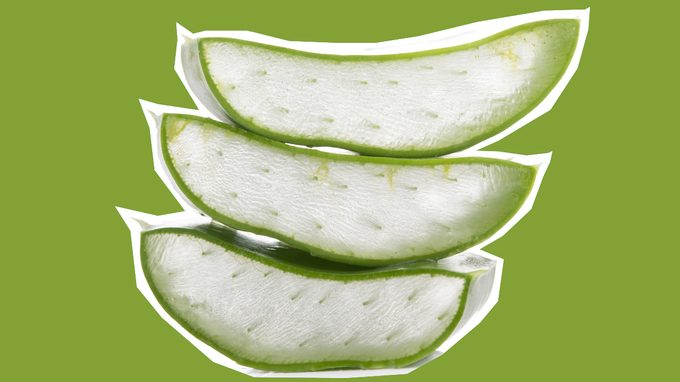The Surprising (And Some Expected) Health Benefits of Aloe
Aloe is a super plant with healing powers. But it’s not just a topical solution to what ails you. In fact, when eaten, it can soothe your body too.
 photo credit: shutterstock
photo credit: shutterstock
The health benefits of aloe – for your skin and more!
Most of us know aloe as a desert cactus that’s good for soothing sunburns. But this multi-purpose plant does more than that; it can also bring nourishment and comfort to the intestines. This is the truest meaning of comfort food.
You probably have plastic tubes of aloe gel hiding away in Your medicine cabinet for those summer days when you need to cool off your skin after too much UV exposure. But here’s what few of us consider: If a natural edible substance is soothing to our outsides, is it possible that it can soothe and bring comfort to our insides, too? In the case of aloe, the answer is yes.
We commonly find aloe in gel form at the pharmacy, often bright green and served up with filler ingredients, dyes and fragrances. We may also find aloe juice in bottles at the health food store, often served with other ingredients. Most commercial aloe products are heavily processed and have been deodorized and diluted.
The real magic we’re after is the aloe gel itself, and the best place to get it is straight from the source. This means that the aloe plant you’ve had sunning itself on your windowsill can be used both topically for skin care and internally for digestive healing. Ready to experience the aloe magic? It smells pretty bad, but it sure does work. Just avoid using aloe when taking this medication.
You can find health benefits of aloe inside the plant
You might question the wonders of aloe when you first cut off a leaf. It will ooze a sliminess that stains things purple (be careful!) and has a pungent odour – by pungent, I mean that it will smell like an armpit after some heavy manual labour during a summer heat wave. Let’s get these facts out of the way: It is slimy and smelly. Stay with me here because aloe is also a truly awesome healing food, and the smell and taste are easily masked when used properly.
The polysaccharides found in aloe have an affinity for joints, offering a little lubrication for our creaky bones. These sugar chains also serve to lube up the brain, nervous system and skin, as well as help our immune system fight chronic viral, nanobacteria and fungal infections. Aloe has been shown to be effective in helping to stabilize blood sugar, treat psoriasis, improve chemotherapy outcomes in patients with colorectal cancer and treat irritable bowel syndrome (IBS), as well as inflammatory bowel disease (IBD). Here are more health benefits of aloe.
Most of the healing benefits come down to that slimy factor. The official culinary term is mucilaginous, and we find this quality in foods like soaked chia seeds and soaked flaxseed and herbs like slippery elm and marshmallow root, which have long been used in the natural treatment of stomach ulcers.
In summary, aloe is beneficial internally for the very same reasons we love it on sunburns: It soothes skin and promotes healing on inflamed tissue.
Here is how to use aloe for digestion
You can purchase an aloe plant or you may find whole leaves available in some health food stores. You’ll want to peel off the heavy green outer layer, as this part has an aggressive laxative effect. You can enjoy the benefits of its gel-like interior by soaking it in water and drinking the water, adding chunks (one to two tablespoons) to smoothies or mixing it into gut-healing puddings.
The first few times you consume straight aloe gel, do so in smaller amounts. Its mucilaginous properties can help your body shed mucous buildup from the lining of your intestines, which may result in a mild cleansing effect (loose poops). It should pass within a day or so and you can slowly build up to two tablespoons per serving. Or you can try this easy-on-the-tummy chia and aloe pudding recipe.




